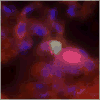Pregnancy-associated progenitor cells: an under-recognized potential source of stem cells in maternal lung
- PMID: 21546085
- PMCID: PMC3157495
- DOI: 10.1016/j.placenta.2011.04.007
Pregnancy-associated progenitor cells: an under-recognized potential source of stem cells in maternal lung
Abstract
Novel therapies are needed for the treatment of acute and chronic lung diseases, many of which are incurable. The use of exogenous stem cells has shown promise in both animal models and clinical trials. However, to date, the stem cell literature has under-recognized naturally acquired pregnancy-associated progenitor cells (PAPCs). These cells are found at sites of injury or disease in female tissues. They persist for decades after parturition in maternal blood and organs, with the largest number being found in the maternal lungs. Their presence there may be one explanation for the sex differences observed in the prevalence and prognosis of some lung diseases. Although the clinical significance of these cells is as yet unknown, the literature suggests that some of the PAPCs are stem cells or have stem cell-like properties. PAPCs harvested from the blood or organs of parous women could potentially be used as an alternate source of cells with regenerative properties for the woman herself or her children. Because PAPCs preferentially traffic to the maternal lung they may play a significant role in recovery or protection from lung disease. In this review article, we discuss ongoing research investigating the administration of both adult and placenta-derived stem cells to treat lung disease, and how PAPCs may also play an important future therapeutic role.
Copyright © 2011 Elsevier Ltd. All rights reserved.
Figures


Similar articles
-
Pregnancy-associated progenitor cells differentiate and mature into neurons in the maternal brain.Stem Cells Dev. 2010 Dec;19(12):1819-30. doi: 10.1089/scd.2010.0046. Epub 2010 Sep 13. Stem Cells Dev. 2010. PMID: 20707697
-
The love-shaper: role of the foetus in modulating mother-child attachment through stem cell migration to the maternal brain.Eur J Contracept Reprod Health Care. 2023 Aug;28(4):216-222. doi: 10.1080/13625187.2023.2216326. Epub 2023 Jun 9. Eur J Contracept Reprod Health Care. 2023. PMID: 37293833 Review.
-
Molecular basis of lung tissue regeneration.Gen Thorac Cardiovasc Surg. 2011 Apr;59(4):231-44. doi: 10.1007/s11748-010-0757-x. Epub 2011 Apr 12. Gen Thorac Cardiovasc Surg. 2011. PMID: 21484549 Review.
-
Stem cells and cell therapy approaches in lung biology and diseases.Transl Res. 2010 Sep;156(3):188-205. doi: 10.1016/j.trsl.2010.06.007. Epub 2010 Jul 7. Transl Res. 2010. PMID: 20801416 Free PMC article. Review.
-
Endogenous lung stem cells: what is their potential for use in regenerative medicine?Expert Rev Respir Med. 2010 Jun;4(3):349-62. doi: 10.1586/ers.10.21. Expert Rev Respir Med. 2010. PMID: 20524918 Review.
Cited by
-
Fetal cell microchimerism and susceptibility to COVID-19 disease in women.Infection. 2023 Aug;51(4):1071-1078. doi: 10.1007/s15010-023-02006-x. Epub 2023 Mar 1. Infection. 2023. PMID: 36857020 Free PMC article.
-
Novel insights into the link between fetal cell microchimerism and maternal cancers.J Cancer Res Clin Oncol. 2016 Aug;142(8):1697-704. doi: 10.1007/s00432-015-2110-3. Epub 2016 Jan 8. J Cancer Res Clin Oncol. 2016. PMID: 26746656 Free PMC article. Review.
-
Stem/progenitor cells in endogenous repairing responses: new toolbox for the treatment of acute lung injury.J Transl Med. 2016 Feb 11;14:47. doi: 10.1186/s12967-016-0804-1. J Transl Med. 2016. PMID: 26865361 Free PMC article. Review.
-
Fetal microchimerism and maternal health: a review and evolutionary analysis of cooperation and conflict beyond the womb.Bioessays. 2015 Oct;37(10):1106-18. doi: 10.1002/bies.201500059. Epub 2015 Aug 28. Bioessays. 2015. PMID: 26316378 Free PMC article. Review.
-
Comprehensive analysis of genes expressed by rare microchimeric fetal cells in the maternal mouse lung.Biol Reprod. 2012 Aug 23;87(2):42. doi: 10.1095/biolreprod.112.101147. Print 2012 Aug. Biol Reprod. 2012. PMID: 22674387 Free PMC article.
References
-
- Ariga H, Ohto H, Busch MP, Imamura S, Watson R, Reed W, Lee TH. Kinetics of fetal cellular and cell-free DNA in the maternal circulation during and after pregnancy: implications for noninvasive prenatal diagnosis. Transfusion. 2001;41:1524–1530. - PubMed
-
- O’Donoghue K, Chan J, de la Fuente J, Kennea N, Sandison A, Anderson JR, Roberts IAG, Fisk NM. Microchimerism in female bone marrow and bone decades after fetal mesenchymal stem-cell trafficking in pregnancy. Lancet. 2004;364:179–182. - PubMed
-
- Michaelsson J, Mold JE, McCune JM, Nixon DF. Regulation of T cell responses in the developing human fetus. J Immunol. 2006;176:5741–8. - PubMed
Publication types
MeSH terms
Grants and funding
LinkOut - more resources
Full Text Sources
Medical

